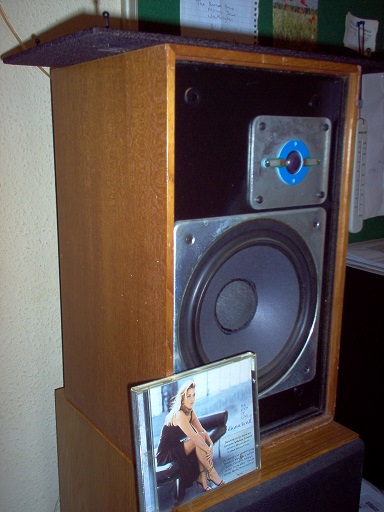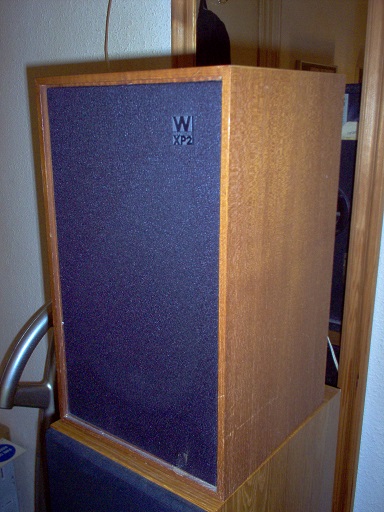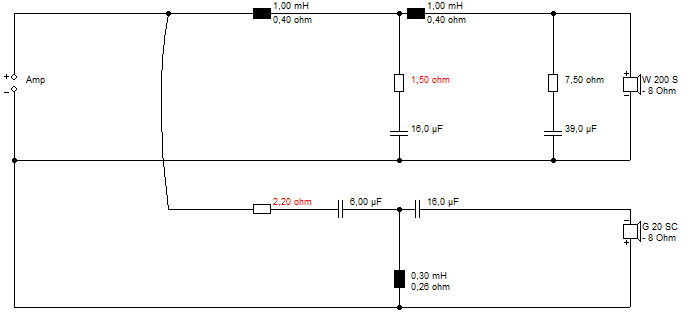Dave
Its interesting that you should mention that because of an experience that I had just last night.
I went to see Saint Vincent. Initially I was not wearing ear protection and I found the sound unbearable, with distortion and god knows what else ringing in my ears. I put on a pair of Etymotic Musicians earplugs and low and behold, the sound was excellent. I have to say that this puzzled me a lot ..........................
And this aligns exactly with my experience. I think as I get older it gets more pronounced, but I have always found with loud sounds that I am concentrating on, that wearing earplugs (even cheap ones) improves clarity. This includes sitting in cinemas, and playing violin in orchestras. I always put it down to my hearing getting "overloaded" which is very unscientific, and probably rubbish.
When listening non-blind we tend to hear what we want to hear.
I'm glad we agree on that.
Member
Joined 2009
Paid Member
DDF
(It's Dave, right?)
Living so close to Waterloo, I have known Stan and John for more like 40-50 years. They have both been guests at my home. But I can't say as I remember such a paper. Do you have a date or a title, or better yet, a link. I'd love to read it.
Hey, I didn't know you are 'local'. I've had the pleasure of meeting John a couple of times - if you are planning to be in Waterloo anytime let me know.
When listening non-blind we tend to hear what we want to hear.
Real psychoacoustic work on "imaging" is very rare. That's why Lidia and I are doing a study as we speak - trying to put some science in front of the smoke screens.
Books like Blauerts would tend to indicate that, scientifically, image should degrade with more very early lateral reflections.
Interesting. Could you perchance give out some details about the study design? Agree that there's a strong need for more systematic data on this. As to the existing research on the effect of reflections on imaging, I harbor some doubts as to the external validity of the findings. Does adding additional lateral reflections artifcially really mimic the effect of a true omni like the Morrisons for example? (closer to being omni that most other "omnis", at least). Maybe the brain adapts in a different way to the reflections if they are coming from all directions at once, and can be subconsciously connected to the source? Or does adding additional artifcial front wall reflections really mimic the effect of a good dipole speaker like the LX521? I'm not sure either.
The most externally valid kind of study, I think, would be to mimic real life listening as close as possible - to compare actual loudspeakes with different directivities, place them optimally, and try and see how people rate their imaging. The problem with this is that the internal validity of the experiment would suffer somewhat, as it becomes more difficult to know if its only the directivity of the loudspeakers which makes the difference, and not other things in the design of the speakers. My 5 cents 🙂
Like I mentioned earlier, the strongest imaging experiences I've had have been with extremely different types of loudspeakers - some highly directional ones (Beolab 50 and 90 in narrow mode, big horns, a Gedlee pair), but also some on the opposite side of the scale (a couple of dipoles and omnis). The in-between kind of directivity seems to me to be the worst of the bunch when it comes to imaging. All sighted and subjective, of course.
Earl,
I wasn't aware of recruitment, thanks for sharing. Sounds awful. Reducing HF SPL with roll off to avoid ear distortion compounds the reduced ability to hear HF detail caused by the hearing loss.
Not to belittle the condition, but this is perhaps best mitigated with some DSP eq in playback vs modifying the speaker. This is one reason why I
- rip all my CDs
- like foobar so much, equalization is pretty clean and can be accomplished at high bit depth (and free!).
BTW: while not up to musicians plugs by any means, cutting foam cylindrical ear plugs in half (to create two equal sized barrels) makes nifty cheap "higher fi" plugs. Much more HF content is let through and the balance is much better than full plugs, with still some very useful broad band attenuation. Saved my hearing at more than a few hard rock shows
Boy, sorry, getting really off topic here
I wasn't aware of recruitment, thanks for sharing. Sounds awful. Reducing HF SPL with roll off to avoid ear distortion compounds the reduced ability to hear HF detail caused by the hearing loss.
Not to belittle the condition, but this is perhaps best mitigated with some DSP eq in playback vs modifying the speaker. This is one reason why I
- rip all my CDs
- like foobar so much, equalization is pretty clean and can be accomplished at high bit depth (and free!).
BTW: while not up to musicians plugs by any means, cutting foam cylindrical ear plugs in half (to create two equal sized barrels) makes nifty cheap "higher fi" plugs. Much more HF content is let through and the balance is much better than full plugs, with still some very useful broad band attenuation. Saved my hearing at more than a few hard rock shows
Boy, sorry, getting really off topic here
Last edited:
The direction this discussion has taken is much more illuminating than the previous. You seem to be comparing alternate models and what works for each.oivavoi
Which brings me to the other discussion. At its root is ones personal listening taste. We settled on two camps; studio work and field recordings. In studio work there is usually a very solid concrete image created in the studio with no acoustical reference at all. It is created in the studio as a work on the canvas of the loudspeakers and as such it is theoretically possible to have a perfect reproduction of this work. Field recordings, on the other hand, can never perfectly recreate the sound field they record and the best that they can do is to create in the listening space an "illusion" of what the original sounded like. This is sometimes refereed to as the "they are here" versus "you are there" effect.
For studio work playback one wants to recreate the original image and this requires a suppression of the very early reflections and diffraction that mess up this image. The loudspeaker tone should closely match those of the studio speakers and this leads to the "circle-of-confusion" that Toole talks about, but that's another discussion. Certainly no studios use omnis for their mastering.
For field work we know that more room reflections yield a more spacious sound thus helping to create the illusion of being in the large recording space.
These two requirements are diametrically opposed and no loudspeaker design can ideally meet both. For studio work a High DI is desired and the playback room size is not a huge issue. For field work a lower DI (but still smooth and constant) is desirable and the larger the room the better the illusion.
Does the short early arrival times in a small room destroy the illusion of spaciousness on a speaker with a low directivity index? A relative used to have a set of Quad Electrostatics in a small room. The ambiance was quite impressive, and I always wondered if the lack of side reflections had something to do with it. It did not sound as impressive when he moved them to a larger room
I am old enough to remember the roll out of the Bose 901. My initial impression in a large demo room with orchestral material was Wow! Later auditions in normal listening rooms reproducing smaller ensembles quickly took away the luster.
The 901...we are old. My comment is that ambience in studio recordings, which are usually layered up of tracks recorded at different times - phoned in so to speak - must be conjured up somehow, whereas live recordings in performance halls of acoustic instruments (and voice) just have to "hear" the room. In other words, some of us are oriented toward orchestral music as the real deal, and you other guys prefer a manufactured sound.
Wait! I like that too! Have I caught the diversity virus?
Wait! I like that too! Have I caught the diversity virus?
Interesting. Could you perchance give out some details about the study design?
My speakers have quite a high DI and as such they can be pointed to avoid the first sidewall reflection, but that increases the second alternate wall reflection. Very early on I did a test with the speakers toed in and then toed out. This test was valid because the directivity is completely symmetric and so one is in exactly the small listening axis response in both cases, both cases being flat and smooth. The difference is the level of the first two reflections is completely different. Toed in the image was strong and solid while toed out the spaciousness was far greater with a lessor image quality.
Our test is designed to show in a blind controlled test that the first sidewall reflection to the near ear will have a worse effect on localization blur that a contra-lateral reflection to the opposite ear.
Earl,
I wasn't aware of recruitment, thanks for sharing.
Recruitment means that when we have hearing loss it is usually only for the low level sounds - the cochlear amplifier which gives us such high dynamic range isn't working very well. This means that for high SPLs we still hear with the same sensitivity. A little thought will show that this results in an abnormal growth of loudness with level. The exact same thing happens to everyone at LFs where a 30 Hz tone at 80 dB SPL will sound 10 dB louder if the level is turned up just 3 dB (see Fletcher-Munson.) But we grow up with this and it never seems to bother us. But recruitment at HFs would likely be problematic because we are not used to it and those are the frequencies that account for intelligibility. It could also be that the ear creates distortion as a direct result.
Everyone will get this as we age, some much worse than others, so don't think that it "won't happen to me".
My hearing loss is far from abnormal. I just know what it is because I live with an audiologist who teats it regularly. Most musicians and audiophiles will have worse than normal hearing loss because they tend to listen to loud music more often than normal. Hearing loss is cumulative and never corrects.
Last edited:
Does the short early arrival times in a small room destroy the illusion of spaciousness on a speaker with a low directivity index?
I don't think that it will destroy the illusion of spaciousness, more likely enhance it or not change it. But an omni in a small room will seriously degrade localization (Image.)
Wait! I like that too! Have I caught the diversity virus?
More like you will have to decide which is more important to you. You can't optimize for both.
Does our brain recognize the interval from the first arrival to give us a cue of large vs small environment, or can the recording fool us?I don't think that it will destroy the illusion of spaciousness, more likely enhance it or not change it. But an omni in a small room will seriously degrade localization (Image.)
an omni in a small room will seriously degrade localization (Image.)
...in the perception of some listeners
I would not call omnidirectional speakers the opposite of narrow directive speakers.. This must be qualified by where they are placed. Geometrically, there is no place where a source can blend properly with an entire room unless you break it down into regions and prioritise. Even then, the best geometric room/speaker fit for a point source might be in a corner, where there won't be early reflections and the result will be largely the same as the narrow directivity method.If you can't beat the room, why not work with it, and make the reflections as similar as possible to the first wave arrival? My experience so far is that the speakers I've liked the most are polar opposites (pun intended) when it comes to directivity: I like very much highly directional speakers, whether cardioids or big horns, and I also like very much speakers with very wide directivity, as long as it's even with frequency. What I don't like so much are the ones in the middle.
I think you folks are making this way more difficult than it is. You hear the speaker and you hear the room. And finding a good position for the speaker clearly matters.
I think there are a few classic designs where everything comes together well.

8" bass and 3/4" mylar tweeter in closed box by the wall is one. Even the grille cloth helps. It takes out the excess 5-10kHz energy mylar always has.

BW3 style filter here. My impedance correction is just a modelling device I used because the W200S is an unusually high inductance woofer.

This is a nice way to do things. Very flat impedance. Good power response. Quite restrained tweeter level, because this isn't a monitor. Not too much bass. Sufficiently steep filters to take out the nasties. FWIW, one of the old studio ideas is the speakers go against a hard wall, and you have thick curtains behind the listening position to take out the rear reflection. That works.
I think there are a few classic designs where everything comes together well.
8" bass and 3/4" mylar tweeter in closed box by the wall is one. Even the grille cloth helps. It takes out the excess 5-10kHz energy mylar always has.
BW3 style filter here. My impedance correction is just a modelling device I used because the W200S is an unusually high inductance woofer.
This is a nice way to do things. Very flat impedance. Good power response. Quite restrained tweeter level, because this isn't a monitor. Not too much bass. Sufficiently steep filters to take out the nasties. FWIW, one of the old studio ideas is the speakers go against a hard wall, and you have thick curtains behind the listening position to take out the rear reflection. That works.
Last edited:
Does our brain recognize the interval from the first arrival to give us a cue of large vs small environment, or can the recording fool us?
From my knowledge this early gap is very important to the creation of image and the sense of the room size. I don't see how if the recording has a 50 ms gap and the playback room only has a 10 ms gap that the ear/brain would not detect this. But audiophools always seem to be able to fool themselves, so there is no telling what they might be fooled by.
From my knowledge this early gap is very important to the creation of image and the sense of the room size. I don't see how if the recording has a 50 ms gap and the playback room only has a 10 ms gap that the ear/brain would not detect this. But audiophools always seem to be able to fool themselves, so there is no telling what they might be fooled by.
not just "audiophools" please
You wouldn't call Bob Olhsson (quoted above) or Dave Moulton (awarded AES Fellowship) "audiophools"
or prof. William Hartmann (search "Simple Dereverberation Experiment", unfortunately the source webpage is no longer online, but IIRC You declared that You knew the author - David Carlstrom)
Last edited:
More like you will have to decide which is more important to you. You can't optimize for both.
Obviously, that's one of the reasons I said I thought a compromise was probably best
You wouldn't call Bob Olhsson (quoted above) or Dave Moulton (awarded AES Fellowship) "audiophools"
or prof. William Hartmann (search "Simple Dereverberation Experiment", unfortunately the source webpage is no longer online, but IIRC You declared that You knew the author - David Carlstrom)
I fail to follow the point that you are trying to make.
Yes, I knew Bill Hartmann, he was a Prof at Mich. State. When I was looking at PhD programs I naturally interviewed with him as I lived in Michigan. I decided to go to Penn State, a decision that I have never regretted. At Penn state my adviser Dr. Jiri Tichy (dept. Head) did not think very highly of Dr. Hartmann and who am I to argue with my adviser.
I'm also an AES Fellow.
- Status
- Not open for further replies.
- Home
- Loudspeakers
- Multi-Way
- Well I suppose the shallow vs. steep argument will just go on and on
